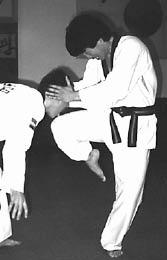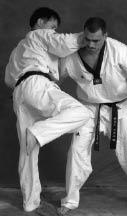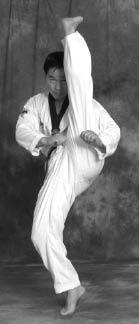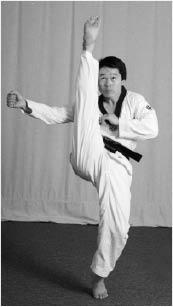Complete Kicking (12 page)
Authors: Turtle Press

THE KNEE: the king of kicks
The knees are the most powerful weapon of your body. In most traditional martial arts competition, knee kicks are prohibited due to their potentially dangerous effects. In modern combat arts, knee kicks are known for their brutal destructive force in both standing and ground fighting.
Visualize your Kick
There are two types of visualization that you can use to improve your kicking. The more basic method is technique-specific. Begin with this and then move on to the mind-specific method as you advance.
1. Technique-specific: See or visualize yourself doing a technique step-by-step in great detail, such as the five stages of each kick: Ready, Shift, Pivot, Kick, and Repose. This is a good way to improve the accuracy of a technique.
2. Mind-specific: Mentally focus on the technique as a whole. In your mind, see yourself giving a perfect performance, like a movie star. This is a good way to improve the speed and efficiency of your techniques.
applications
Knee kick is the most powerful kick in a close quarters fight. A solid knee kick to the outer thigh or groin can easily send an opponent to the floor. A kick to the rib cage or solar plexus can stop the opponent’s breathing. A kick to the chin or the nose can result in an instant knockout. On the ground, a knee kick is useful for keeping an opponent on defense or weakening his resolve.
SPORT APPLICATIONS
Grasp the side or rear of the opponent’s head to hold him in place for an upward knee kick.
Grab behind the opponent’s neck to drive his body downward into your roundhouse knee kick to the lower abdomen.
SELF-DEFENSE APPLICATIONS
A drop knee kick is a powerful way to finish a downed assailant.
Subdue a struggling assailant with knee kicks to the ribs.
common mistakes
MISTAKE 1: The most common error in knee kicking is angle control - either because the knee is not folded tightly or because the hip is opened too wide.
SOLUTION: Keep your knee folded as sharply as possible and thrust your pointed knee using the snapping force of your pelvis. By keeping your knee folded tightly and using your pelvis to control the direction of the kick, you’ll find it easier to control the angle of your strike.
MISTAKE 2: Another common problem is distance control, often due to hesitation.
SOLUTION: Don’t wait for perfect time to strike. In practice, focus on seizing the moment and throwing your knee instinctively to openings on the thigh, stomach, kidney, chest, neck or head.
• remember
1. Point your knee.
2. Use your pelvis for power and control.
3. Practice short, middle, and long knee kicks.
4. Synchronize the upward motion of your knee with the downward movement of your hands.
5. Exhale when kicking.
• avoid
1. Poor angle of kick, not folding the knee tightly
2. Wide arc of kick, opening your hip too wide
3. Tardy execution
4. Muscle tension
5. Striking with the edge of the kneecap
6. Self-injury
RAISING KICK
purpose
Raising kick is used to improve leg flexibility. However, if you drop your foot with force after raising it, it becomes an axe kick. If you kick an opponent who is behind you, it becomes a rear kick. It can also scare an opponent into backing up so you can follow up with a primary kick.
key points
Relax your body and keep your torso erect to gain kicking height. Keep your arms near the kicking leg for balance and control.
striking area
Ball, toes, bottom of the foot, heel
targets
1. head
2. sternum
how to
1. From fighting stance, shift your weight to the front leg.
2. Bring your straight leg up toward your chest and let your foot go over your shoulder. Do not put any power in this movement; simply focus on raising your leg as high as possible.
3. Return your leg along the same path in a relaxed but controlled way.
*Breathe out as you raise your leg and breathe in as you lower your leg.
variation
1. Pull your toes downward for an extra stretch in your hamstring muscles.
2. Point your toes to get extra length in your kick.
applications
Although raising kick is primarily used for improving flexibility and the height of your kicks, it can be practical in unusual ways, perhaps due to the element of surprise. In just the right situation, raising kick can be a practical way to shock an opponent with an unorthodox counter-movement.
Other books
Survivalist - 15.5 - Mid-Wake by Ahern, Jerry
Still Pitching by Michael Steinberg
The Heavenly Man by Brother Yun, Paul Hattaway
The Festival of Bones: Mythworld Book One by James A. Owen
The Sartious Mage (The Rhythm of Rivalry) by Narro, B.T.
Home Team by Sean Payton
Days of Your Fathers by Geoffrey Household
Eve and Adam by Grant, Michael, Applegate, Katherine
The Left Series (Book 5): Left On The Run by Fletcher, Christian







